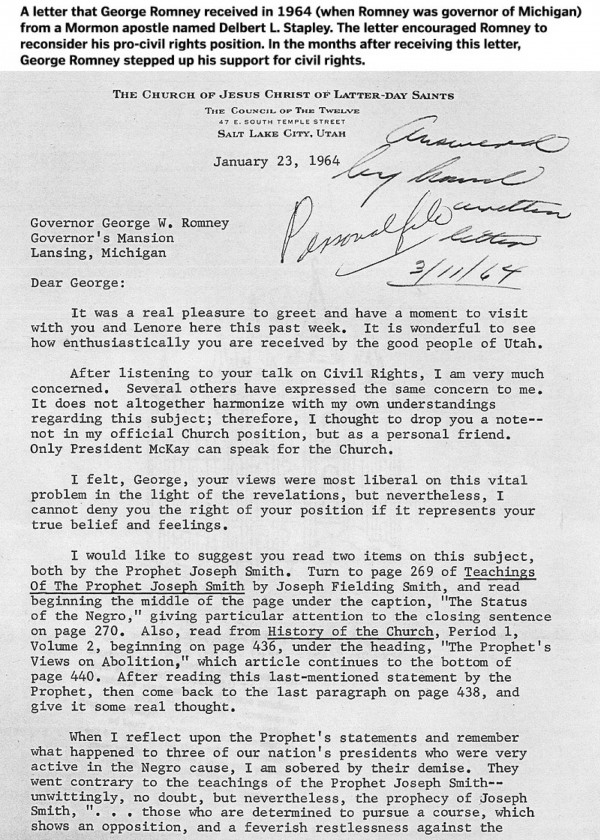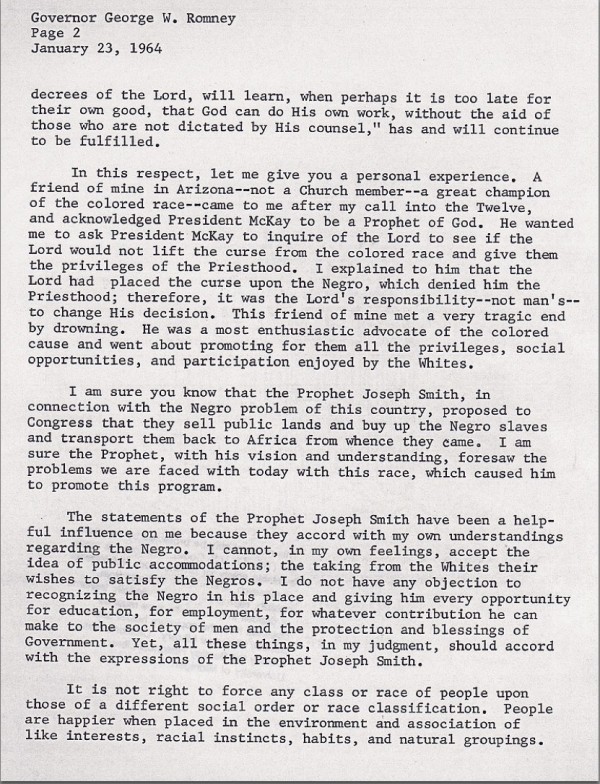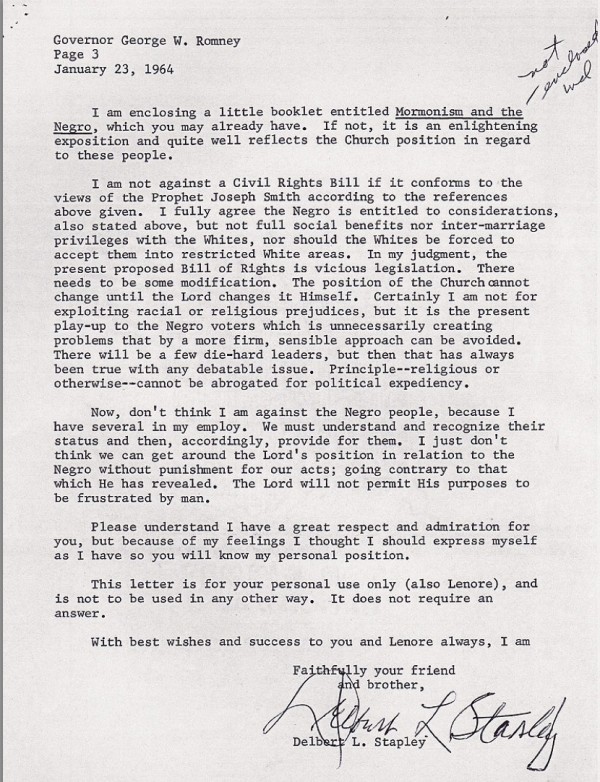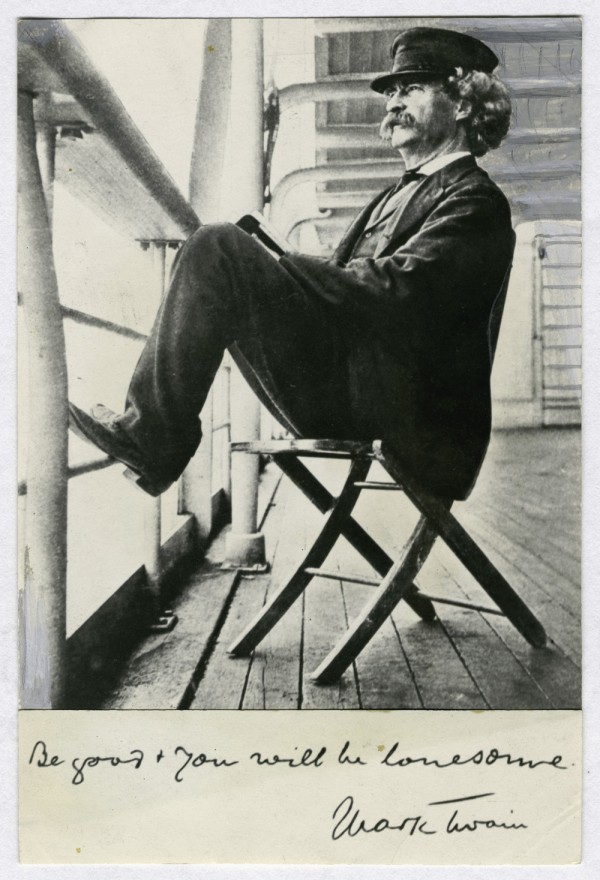
THE NEW YORKER: Scholarly opinion on {Mormonism founder Joseph] Smith now tends to divide between those who think that he knew he was making it up and those who think that he sincerely believed in his own visions—though the truth is that, as Melville’s “Confidence Man” reminds us, the line between the seer and the scamster wasn’t clearly marked in early-nineteenth-century America. Mark Twain read the Book of Mormon and, knowing what Smith would have read, not to mention knowing about frontier fakery, came to conclusions about both the sources of its prose and the sequence of its composition. MORE
MARK TWAIN: All men have heard of the Mormon Bible, but few except the “elect” have seen it, or, at least, taken the trouble to read it. I brought away a copy from Salt Lake. The book is a curiosity to me, it is such a pretentious affair, and yet so “slow,” so sleepy; such an insipid mess of inspiration. It is chloroform in print. If Joseph Smith composed this book, the act was a miracle–keeping awake while he did it was, at any rate. If he, according to tradition, merely translated it from certain ancient and mysteriously-engraved plates of copper, which he declares he found under a stone, in an out-of-the-way locality, the work of translating was equally a miracle, for the same reason. The book seems to be merely a prosy detail of imaginary history, with the Old Testament for a model; followed by a tedious plagiarism of the New Testament. The author labored to give his words and phrases the quaint, old-fashioned sound and structure of our King James’s translation of the Scriptures; and the result is a mongrel–half modern glibness, and half ancient simplicity and gravity. The latter is awkward and constrained; the former natural, but grotesque by the contrast. Whenever he found his speech growing too modern–which was about every sentence or two—he ladled in a few such Scriptural phrases as “exceeding sore,” “and it came to pass,” etc., and made things satisfactory again. “And it came to pass” was his pet. If he had left that out, his Bible would have been only a pamphlet.
The title-page reads as follows:
THE BOOK OF MORMON: AN ACCOUNT WRITTEN BY THE HAND OF MORMON, UPON PLATES TAKEN FROM THE PLATES OF NEPHI.
Wherefore it is an abridgment of the record of the people of Nephi, and also of the Lamanites; written to the Lamanites, who are a remnant of the House of Israel; and also to Jew and Gentile; written by way of
commandment, and also by the spirit of prophecy and of revelation. Written and sealed up, and hid up unto the Lord, that they might not be destroyed; to come forth by the gift and power of God unto the interpretation thereof; sealed by the hand of Moroni, and hid up unto the Lord, to come forth in due time by the way of Gentile; the interpretation thereof by the gift of God. An abridgment taken from the Book of Ether also; which is a record of the people of Jared; who were scattered at the time the Lord confounded the language of the people when they were building a tower to get to Heaven.
“Hid up” is good. And so is “wherefore”–though why “wherefore”? Any other word would have answered as well–though–in truth it would not have sounded so Scriptural. Next comes:
THE TESTIMONY OF THREE WITNESSES.
Be it known unto all nations, kindreds, tongues, and people unto whom this work shall come, that we, through the grace of God the Father, and our Lord Jesus Christ, have seen the plates which contain this record, which is a record of the people of Nephi, and also of the Lamanites, their brethren, and also of the people of Jared, who came from the tower of which hath been spoken; and we also know that they have
been translated by the gift and power of God, for His voice hath declared it unto us; wherefore we know of a surety that the work is true. And we also testify that we have seen the engravings which are upon the plates; and they have been shown unto us by the power of God, and not of man. And we declare with words of soberness, that an angel of God came down from heaven, and he brought and laid before our eyes, that we beheld and saw the plates, and the engravings thereon; and we know that it is by the grace of God the Father, and our Lord Jesus Christ, that we beheld and bear record that these things are true; and it is marvellous in our eyes; nevertheless the voice of the Lord commanded us that we should bear record of it; wherefore, to be obedient unto the commandments of God, we bear testimony of these things. And we know that if we are faithful in Christ, we shall rid our garments of the blood of all men, and be found spotless before the judgment-seat of Christ, and shall dwell with Him eternally in the heavens. And the honor be to the Father, and to the Son, and to the Holy Ghost, which is one God. Amen.
OLIVER COWDERY,
DAVID WHITMER,
MARTIN HARRIS.
Some people have to have a world of evidence before they can come anywhere in the neighborhood of believing anything; but for me, when a man tells me that he has “seen the engravings which are upon the plates,” and not only that, but an angel was there at the time, and saw him see them, and probably took his receipt for it, I am very far on the road to conviction, no matter whether I ever heard of that man before or not, and even if I do not know the name of the angel, or his nationality either. MORE
BOOK OF MORMON HISTORY: Joseph Smith [founder of Mormonism] was given a vision of both God and Jesus. His new calling was to be a prophet of God. In his visions, he was told that none of the current Churches were teaching the full truth, and he was chosen to start a new Church. He was led by God to discover an ancient record, and given the ability to translate it into English. This was the Book of Mormon. The Book of Mormon is a sacred text of the Church of Latter Day Saints. It was first published in March 1830 by Joseph Smith, Jr. as “The Book of Mormon: An Account Written by the Hand of Mormon upon Plates Taken from the Plates of Nephi.” According to Smith’s account and the book’s narrative, the Book of Mormon was originally written in otherwise unknown characters referred to as “reformed Egyptian,” engraved on golden plates. Joseph Smith received these plates in 1827 from an angel named Moroni. Moroni was the son of Mormon, a prophet born in 310 AD Central America. Mormon had spent his life involved with warfare. His people, called the Nephites, defended themselves against the Lamanites. In 385 AD the Lamanites defeated the Nephites in one great, last battle. Mormon was instructed by God to make a historical account of his people in writing. His culture had many records engraved on thin gold or brass plates. He used these as a reference and engraved his own narrative of the history of God’s dealings with his people on Earth. Plates of NephiBy referring to many volumes of records, which were engraved upon thin gold or brass plates, Mormon engraved his own narrative style history of the Lord’s dealings with His people in the New World. Before going to war with the Lamanites for the final battle, Mormon gave his son Moroni the plates. Moroni finished the book and became the last known survivor of the Nephite nation. The plates were finished by Mornoni and buried, where they remained until Joseph Smith was called upon to translate them into English. MORE
WIKIPEDIA: According to the Book of Mormon, a religious text of The Church of Jesus Christ of Latter-day Saints, a Nephite is a member of one of the four main groups of settlers of the ancient Americas. The other early settlers described in the Book of Mormon include the Lamanites, Jaredites and Mulekites. Some LDS scholars believe that the forebears of the Nephites settled somewhere in present-day Central America after departing Jerusalem.[2] However, both the Smithsonian Institution[3] and the National Geographic Society have issued statements that they have seen no evidence to support these claims in the Book of Mormon and furthermore, no secular archeologist or historian has supported their existence. MORE
NATIONAL GEOGRAPHIC SOCIETY: We know of no archaeological evidence that corroborates the ancient history of the Western Hemisphere as presented in the Book of Mormon, nor are we aware of empirical verification of the places named in the Book of Mormon. The Book of Mormon is clearly a work of great spiritual power; millions have read and revered its words, first published by Joseph Smith in 1830. Yet Smith’s narration is not generally taken as a scientific source for the history of the Americas. Archaeologists and other scholars have long probed the hemisphere’s past, and the Society does not know of anything found so far that has substantiated the Book of Mormon. MORE
SMITHSONIAN INSTITUTION: The Smithsonian considers the Book of Mormon a religious document and not a scientific guide. The Smithsonian Institution has never used it in archaeological research and has found no archaeological evidence to support its claims. MORE
NEW YORKER: The Book of Mormon is, in any case, only one of many pronouncements that Smith offered his new troops, apparently improvising as he went along, according to the shifting spiritual needs of the moment. (After other followers began to have revelations from angels of their own, the Holy Ghost inspired Smith to the conclusive revelation that only hisrevelations ought to be church policy.) […] Forced out of New York by an earlier version of that fierce Protestant hostility, Smith and his followers began their years of wandering. Wherever they went, they infuriated the non-Mormon locals, and also managed to infuriate one another: the early 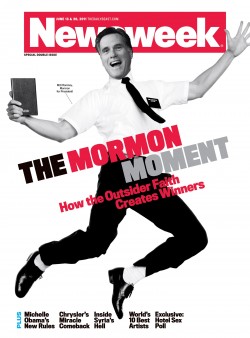 history of the movement involves a bewildering series of excommunications, internal banishments, and the increasing threat of violence to enforce new rules as Smith received them. Smith was eventually martyred by a mob in Carthage, Illinois, while in the local jail awaiting trial for treason. Which of his doctrines enraged the mob is hard to grasp, but it may have been sex more than heresy. You could have as many doctrines as you liked, but not as many wives. There the story might have ended. Yet as a rule the success of a new religious movement depends not so much on the mystical visions of its founder as on the executive energy of its first evangelist. Christianity may be Jesus’ intuition, but it is Paul’s institution, and the Nation of Islam owed less to the mysterious preachments of Wallace Fard than to the organizational tenacity of Elijah Muhammad. Brigham Young inhabited this role for the Mormons, and about as fully as any apostle ever has. Young was one of Smith’s earliest followers, a hard-bitten character from Vermont who, inheriting Smith’s mantle, got his posse of believers out West and, instead of pushing forward along the Oregon Trail and joining the gold rush, chose an arid but suitable piece of land, planted his people there, and, in 1847, began building a wooden tabernacle in the town he called Salt Lake City. MORE
history of the movement involves a bewildering series of excommunications, internal banishments, and the increasing threat of violence to enforce new rules as Smith received them. Smith was eventually martyred by a mob in Carthage, Illinois, while in the local jail awaiting trial for treason. Which of his doctrines enraged the mob is hard to grasp, but it may have been sex more than heresy. You could have as many doctrines as you liked, but not as many wives. There the story might have ended. Yet as a rule the success of a new religious movement depends not so much on the mystical visions of its founder as on the executive energy of its first evangelist. Christianity may be Jesus’ intuition, but it is Paul’s institution, and the Nation of Islam owed less to the mysterious preachments of Wallace Fard than to the organizational tenacity of Elijah Muhammad. Brigham Young inhabited this role for the Mormons, and about as fully as any apostle ever has. Young was one of Smith’s earliest followers, a hard-bitten character from Vermont who, inheriting Smith’s mantle, got his posse of believers out West and, instead of pushing forward along the Oregon Trail and joining the gold rush, chose an arid but suitable piece of land, planted his people there, and, in 1847, began building a wooden tabernacle in the town he called Salt Lake City. MORE
NEW YORKER: All of which leads to the inevitable question: To what degree is Mormonism responsible for Mitt Romney? Is there a thread, dark or golden, that runs from Moroni to Mitt? Garry Wills has argued, after all, that Irish Catholic ideas about sin—that sin is negotiable currency, to be practiced, done penance for, forgiven—allowed John Kennedy some serenity as he screwed his way through the White House typing pool, just as the habits of Protestant Evangelical belief, in forgiveness and temptation and forgiveness, in a never-ending cycle, helped Bill Clinton find a common language with working-class people. The most striking feature of Mitt Romney as a politician is an absence of any responsibility to his own past—the consuming sense that his life and opinions can be remade at a moment’s need. Romney, according to Romney, never favored the individual mandate, or supported abortion rights, or opposed the auto-industry bailout, or did any of the other things he obviously, and on the record, did.
One could presumably make a case that beleaguered faiths always shy from admitting errancy in public. Dominant faiths can afford tales of failure and redemption, with sinners becoming saints and saints dropping in and out of the calendar like blue-plate specials; beleaguered ones have to put on a good face in public and never lose it. Donny Osmond talks about the anxieties that arose from a need to appear perfect, and the impossibility of admitting in public to flaws or errors. Better to have a new revelation about, say, health-care mandates that renders the previous one instantly inoperable than spend time apologizing for the old ways. When, in 1978, the Church of Jesus Christ of Latter-day Saints abandoned the rule prohibiting blacks from serving as priests, one church leader, Bruce McConkie, explained, “It doesn’t make a particle of difference what anybody ever said about the Negro matter before the first day of June 1978.” You could find, or think you’ve found, a similar logic behind Romney’s blithe amnesia when it comes to the things he used to think and say. MORE
SLATE: “God has always been discriminatory.” So says Randy Bott, a professor of religion at Brigham Young University, in a Washington Post piece by Jason Horowitz. […] Bott’s comments—about which more below—were incendiary. But they wouldn’t have any significance were it not for the LDS Church’s complicated and troubling history with regard to race, a history that many Mormons might have hoped was safely in the past. Starting shortly after the death of the church’s founder, Joseph Smith, in 1844, the Mormon Church began denying its priesthood—otherwise granted to faithful young men over the age of 12 more or less as a matter of course—to men of African descent. That policy survived for well over a century. Only with a divine revelation announced by then-prophet Spencer W. Kimball in 1978 did the church finally overturn the ban and allow “all worthy males,” regardless of race, full and equal membership in the religion.Why did the church withhold the priesthood from blacks for over a century? Among the reasons trotted out by church leaders—including church presidents—during that time: Black people are the cursed descendants of ancient Biblical figures; black people committed pre-mortal perfidy; black people lacked the intelligence and personal integrity to hold such a sacred office. Such past beliefs have never officially been repudiated. And the failure of the church to repudiate them helped set the stage for the comments made by Randy Bott, perhaps the most popular professor at BYU (and at one point, according to ratemyprofessors.com, the most popular professor in the country). MORE
WIKIPEDIA: George Romney is reported to have accelerated his engagement in the civil rights cause shortly after receiving the letter. MORE
CHURCH OF LATTER DAY SAINTS: In early June of [1978], the First Presidency announced that a revelation had been received by President Spencer W. Kimball extending priesthood and temple blessings to all worthy male members of the Church. President Kimball has asked that I advise the conference that after he had received this revelation, which came to him after extended meditation and prayer in the sacred rooms of the holy temple, he presented it to his counselors, who accepted it and approved it. It was then presented to the Quorum of the Twelve Apostles, who unanimously approved it, and was subsequently presented to all other General Authorities, who likewise approved it unanimously. MORE
WIKIPEDIA: Like those of many, Stapley’s views changed with time and, from his hospital bed, Stapley sustained the First Presidency’s action on June 8, 1978, that all worthy men receive the priesthood, regardless of race.[4] Stapley died on August 19, 1978 in Salt Lake City, Utah. He suffered cardiac arrest at about noon while walking near his home. MORE

